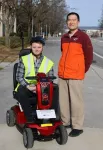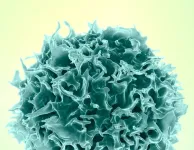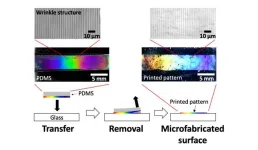(Press-News.org) COLUMBUS, Ohio – Scientists investigating animal viruses with potential to infect humans have identified a critical protein that could enable spillover of a family of organisms called arteriviruses.
In a new study, researchers identified a protein in mammals that welcomes arteriviruses into host cells to start an infection. The team also found that an existing monoclonal antibody that binds to this protein protects cells from viral infection.
Arteriviruses circulate broadly in many types of mammals around the world that serve as natural hosts – such as nonhuman primates, pigs and horses – but so far have not been detected in humans.
The researchers’ aim is to better understand mechanisms of arterivirus infection to get a handle on how high the infection risk is for humans and what preparation may be needed should a spillover occur in the future.
“It’s important to consider that since we have no known arteriviruses infecting people that we’re essentially immunologically naïve, so we can’t rely on preexisting immunity to help us,” said co-lead author Cody Warren, assistant professor of veterinary biosciences at The Ohio State University.
Warren co-led the work with Adam Bailey, assistant professor of pathology and laboratory medicine at the University of Wisconsin-Madison. The study was published recently in Nature Communications.
Many natural hosts of arteriviruses have no signs of disease, but the virus that infects swine can cause pneumonia, as well as abortions in pregnant pigs, and other strains can cause hemorrhagic fever or encephalitis when they switch animal hosts.
These viruses also have the unusual ability to maintain long-term infections and become more virulent when they find new hosts – which gives them time to evolve and improve their chances of transmission.
The research team set out to find proteins in mammals that arteriviruses use as receptors to gain entry to host cells and make copies of themselves. Bailey used genome-wide CRISPR-knockout screening technology to identify specific genes that, when disrupted, rendered cells resistant to viral infection. Such genes would then be considered essential to the viral infection process. The unbiased screen identified two genes, FCGRT and B2M, whose protein products come together to form the FcRn receptor (neonatal Fc receptor) that is expressed on the surface of cells.
The FcRn receptor molecule has a specific role in shuttling antibodies across the placenta to a fetus, but is also present in immune cells and cells that line blood vessel walls – both of which are targeted by arteriviruses.
Results from this study demonstrated that FcRn is used for host cell entry by at least five arteriviruses that infect monkeys, pigs and horses, respectively: three diverse strains of simian arteriviruses, porcine reproductive and respiratory syndrome virus 2 (PRRSV-2), and equine arteritis virus (EAV).
Knocking out the major component of the FcRn complex – the FCGRT gene – from host cells blocked viral infection, and pre-treating cells with a monoclonal antibody against FcRn protected against infection.
There was also a genetic twist to this story: Some mammal hosts were less susceptible to arterivirus infection based on differences in their species-specific FcRn’s sequence, meaning that in some cases, this protein will function as a barrier to cross-species infections.
“Chimpanzees and humans have pretty much all the same genes, but the sequence of those genes is slightly different,” Bailey said. “All mammals have the FcRn receptor, but their ability to support infection with a given arterivirus may vary.”
The CRISPR screen also identified a gene encoding another surface protein, CD163, which Warren and colleagues previously found to be a gatekeeper for an arterivirus called simian hemorrhagic fever virus (SHFV) to infect a cell.
A series of experiments in different cell types and using multiple viral strains in the new study showed that CD163 does have a role in infection by most arteriviruses, but it cannot act alone – interaction with FcRn is also key to facilitating arteriviral infection of host cells.
Spelling out these arterivirus infection steps is an important milestone, the researchers said.
“If we’re looking at virus biology, one of the most important things we can understand is entry mechanisms. Because if you can stop the ability of a virus to infect a cell through disrupting that initial virus-receptor contact, now you have a potential therapeutic strategy,” Warren said.
One of those “disruptors” could be blocking the receptor – so showing that an existing monoclonal antibody can stop viral infection in cells is also a plus for scientists examining viruses through a lens of pre-pandemic preparedness.
“If one of these viruses emerged in humans, I believe we’d be in big trouble,” Bailey said. “So that is the motivator for me.”
This work was supported by National Institutes of Health grants, University of Wisconsin-Madison startup funds, the G. Harold and Leila Y. Mathers Foundation, and the Burroughs Wellcome Fund Pathogenesis of Infectious Disease Program.
Co-authors included Teressa Shaw, Kylie Nennig, Xueer Qiu, Devon Klipsic and Igor Slukvin of UW-Madison; Devra Huey, Makky Mousa-Makky, Jared Compaleo, Fei Jiang and Haichang Li of Ohio State; Aadit Shah of Stanford University; Raymond Rowland of the University of Illinois Urbana-Champaign; and Meagan Sullender and Megan Baldridge of Washington University in St. Louis.
#
Contacts:
Cody Warren, Warren.802@osu.edu
Adam Bailey, ALBailey@wisc.edu
Written by Emily Caldwell, Caldwell.151@osu.edu
END
The visible universe — all the potatoes, gas giants, steamy romance novels, black holes, questionable tattoos, and overwritten sentences — accounts for only 5 percent of the cosmos.
A Virginia Tech-led team is hunting for the rest of it, not with telescopes or particle colliders, but by scrutinizing billion-year-old rocks for traces of dark matter.
In leading a transdisciplinary team from multiple universities on this unconventional search, physics’ Patrick Huber is also taking an unconventional step: from theoretical work into experimental work.
With support from a $3.5 million Growing Convergence Research ...
A new study published October 31, 2024, in the Journal of Geophysical Research: Oceans has revealed significant acceleration in the upper-ocean circulation of the equatorial Pacific over the past 30 years. This acceleration is primarily driven by intensified atmospheric winds, leading to increased oceanic currents that are both stronger and shallower, with potential impacts on regional and global climate patterns, including the frequency and intensity of El Niño and La Niña events. The study provides a spatial view of these long-term trends from observations, adding at least ...
Traditional city planning methods require significant technical expertise and manual work.
A Virginia Tech researcher is working to change that.
New research shows the potential of large language models (LLMs), such as ChatGPT and Google’s Gemini, for assessing the human-made environment using street-view images.
By comparing LLM performance with traditional city planning deep learning methods, the study from the College of Natural Resources and Environment found that LLM-based performance is similar with established approaches. Unlike ...
Irvine, Calif., Oct. 31, 2024 — By creating a new way for light and matter to interact, researchers at the University of California, Irvine have enabled the manufacturing of ultrathin silicon solar cells that could help spread the energy-converting technology to a vast range of applications, including thermoelectric clothing and onboard vehicle and device charging.
The development, subject of a paper recently published as the cover story in the journal ACS Nano, hinges on the UC Irvine researchers’ conversion of pure silicon from an indirect to a direct bandgap semiconductor through the way it interacts ...
WHAT:
A clinical trial sponsored by the National Institutes of Health (NIH) has launched to examine the safety and acceptability of a novel rectal HIV microbicide douche containing the antiretroviral drug tenofovir. This “on-demand” HIV prevention approach involves using the microbicide prior to a potential exposure from receptive anal intercourse.
Several forms of HIV pre-exposure prophylaxis (PrEP) are in use in the United States and globally, namely daily oral pills, long-acting injections, and a monthly vaginal ring. The Centers for Disease Control and Prevention advises that gay, bisexual and other men who have sex with ...
1. A team of researchers from NIMS and the University of Connecticut has developed a printing technique capable of forming a periodic nano/microstructure on the surface of a polydimethylsiloxane (PDMS) slab and easily transferring it onto the surface of a glass substrate. This technique enables us to create materials with useful functions—including water-repellency and the ability to generate structural colors—without expensive equipment and complex processes. In addition, the technique may be used to fabricate materials capable of realizing anti-fogging and/or generating structural colors on their surfaces—functions potentially useful in the development ...
Reports of drug-related supply-chain issues were 40% less likely to result in drug shortages in Canada versus the United States, according to a new study from University of Pittsburgh researchers and published today in JAMA.
The analysis looked at drugs that had reports of supply-chain disruptions between 2017 and 2021 in both countries and found that within 12 months of an initial U.S. report, nearly half resulted in drug shortages in the U.S. versus about one-third in Canada. There was also a consistently lower ...
About The Study: Drug-related reports of supply chain issues were 40% less likely to result in meaningful drug shortages in Canada compared with the U.S. These findings highlight the need for international cooperation between countries to curb the effects of drug shortages and improve resiliency of the supply chain for drugs.
Quote from corresponding author Katie J. Suda, PharmD, MS:
“Our U.S. drug supply chain is linked globally – shortages in one country can happen in another country – presenting an opportunity to compare and ...
About The Study: The results of this prospective cohort study suggest that evidence-based smoking cessation treatment within 6 months following a cancer diagnosis maximizes survival benefit. This study supports smoking cessation as an important early clinical intervention for patients after being diagnosed with cancer.
Corresponding Author: To contact the corresponding author, Paul M. Cinciripini, PhD, email pcinciri@mdanderson.org.
To access the embargoed study: Visit our For The Media website at this link ...
HOUSTON ― Smokers who are diagnosed with cancer now have more incentive to quit, as researchers from The University of Texas MD Anderson Cancer Center have found survival outcomes were optimized when patients quit smoking within six months of their diagnosis.
Study results, published today in JAMA Oncology, found a 22%-26% reduction in cancer-related mortality among those who had quit smoking within three months after tobacco treatment began. The best outcomes were observed in patients who started tobacco treatment within six months of a cancer diagnosis and were abstinent from smoking three months later. Survival for these patients increased from 2.1 years for ...






